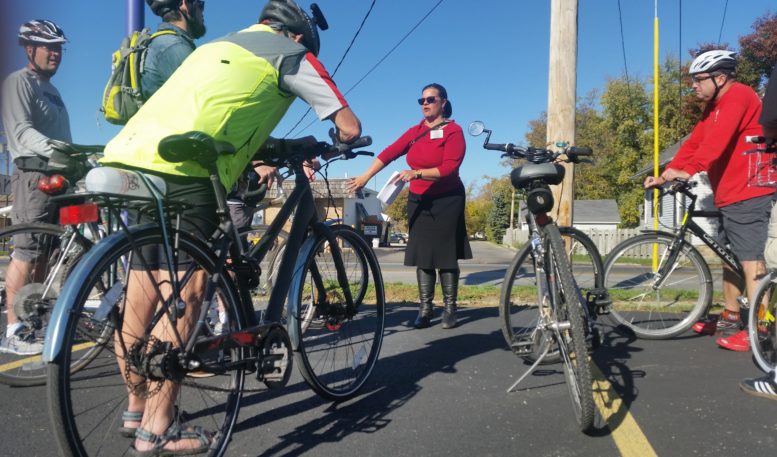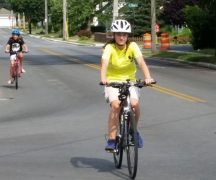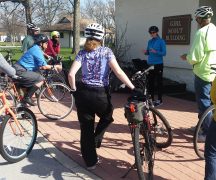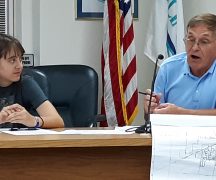By JAN LARSON McLAUGHLIN
BG Independent News
Bowling Green wants residents to become more comfortable shedding their four-wheeled transportation for the two-wheeled type.
But since bike lanes are so expensive, the city is focusing on changing the culture on city streets.
That will involve regularly scheduled “slow roll” group rides in the city, to make people more comfortable bicycling in the city. And it will involve the offer of individual training for people who want to start biking to work or school.
The efforts will hit full speed this month, which is Bicycle Month. Bowling Green students will attend an assembly by Right Direction BMX team on May 15. The second annual Ride of Silence will be held May 16, 6:30, starting in City Park. The worldwide ride is in honor of those killed or injured in bike accidents. Ride to Work and School Day will be held May 18. And the city’s bicycle “spokesperson” will be named on May 21.
On Monday evening, the Bicycle Safety Commission and City Council’s Transportation and Safety Committee held a joint meeting.
Steve Langendorfer talked about the Yay Bikes initiative to support safe bicycling in Bowling Green. The Yay Bikes program sent consultants to BG to train local bicyclists to become more comfortable riding city streets. Those people will soon be working to spread that awareness to other bicyclists in the city, Langendorfer said.
The five people trained locally will offer development bike rides for individuals or for groups. They will cater the training to meet the needs of the riders.
Regular community bike rides will also be scheduled to get more people involved. The particular days and times of the rides have not been determined yet. But they will not be strenuous, and will have stops along the route.
City Engineer Jason Sisco said that “theme” bike rides are being considered – such as rides that stop at ice cream shops along the way.
The goal is to make cyclists more comfortable and motorists more accustomed to sharing the roads.
In Columbus, where Yay Bikes is located, changes are being seen, according to Langendorfer.
“Traffic has changed. Motorists actually are more accepting of bicyclists,” he said.
At the same time, bicyclists are working to obey traffic laws.
“Cars have responded,” Langendorfer said. The number of beeping horns at bicyclists, “suddenly started diminishing.”
City Council member John Zanfardino mentioned that weekly bike rides used to be held in Bowling Green, organized by a group called Bikers for a Better BG. He was pleased that regular rides might be returning.
Zanfardino was one of several citizens and city officials training two summers ago by Yay Bikes staff. It took a while to get used to the suggestion that bicyclists not hug the curb, but rather ride about where the passenger side tire of vehicles hits the road, he said.
“A bike has as much of a right to be there as a car,” Zanfardino said. “There’s a recognition of everyone having the right to be on the road.”
The more bicyclists follow that rule, “the more it’s going to become a bike riding culture in town,” he said.
Sisco agreed that the first rides can be uncomfortable. But then there’s the “aha” moment. “You realize, wow, this really does work.”
Helping make Bowling Green more bicycle friendly is a new map created by the Bicycle Safety Commission, which designates every city street as green for really safe, yellow for less comfortable, and red for busy.
The suggestion is that bicyclists should “be mindful of the red and yellow streets,” Zanfardino said.
The map can be found on the city’s website. Council member Greg Robinette praised the effort of the commission to assess the ride-ability of every street.
In the past few years, the city has talked about physical accommodations for bikes – like sharrows or bike lanes. To make the changes less expensive, officials discussed making changes to roadways while they were under regular maintenance.
Since Manville Avenue is scheduled for repaving this year, Zanfardino asked if this might be a good time to add sharrows to that road. In the future, major changes are proposed for South Main Street, he added.
However, Zanfardino also mentioned the damage to the sharrows that were put on Fairview and Conneaut streets last year. Each of the sharrows cost $300.
“It’s made me rethink, do we need to go the more expensive route,” or just paint on the sharrows, he said.
Council member Bruce Jeffers also liked the idea of coordinating the biking efforts with repaving projects.
“We need to be connecting larger pathways – real destinations for people,” he said.
But only putting sharrows on streets when they are being paved will be a slow process, Zanfardino cautioned.
In the city’s Community Action Plan, two bicycling priorities have risen to the top of council’s list.
One priority would be new on-street bicycle lanes along Court Street. Feedback from last year’s Court Street Connects event showed strong support for the bike lanes.
The other is for bicycle infrastructure on Clough Street, Scott Hamilton Avenue, Thurstin Avenue and College Drive corridors. This would provide bicyclists with their own designated space on the road, for safety concerns. Providing the infrastructure to reduce the risk of accidents and dispel perceptions of danger is a preliminary step to encouraging students to commute by bicycle.
“We’re moving forward on a number of fronts,” Robinette said.
Also at the joint meeting on Monday, Kathleen Pahl presented information on the Safe Routes to School program.
“The community and the school district can work together to benefit everybody,” she said.
The first step would be for the school district to conduct a travel plan to see if infrastructure or education are needed. Then an application can be made to the Ohio Department of Transportation for funding of projects such as sharrows, sidewalks and bike trails. The grants offer up to $15,000 for non-infrastructure, and up to $400,000 for infrastructure projects.




